
Joint Chiefs of Staff
Wikipedia | 2012-10-17 12:55
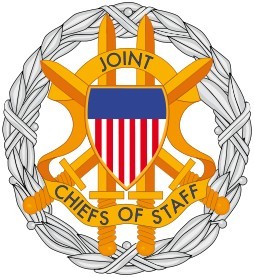
Symbol of the Joint Chiefs of Staff of the United States of America
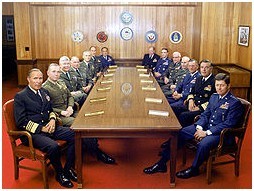
The Joint Chiefs of Staff and several Commanders in Chief, 1 July 1983
The Joint Chiefs of Staff (JCS) is a body of senior uniformed leaders in the United States Department of Defense who advise the Secretary of Defense, the Homeland Security Council, the National Security Council and the President on military matters. The composition of the Joint Chiefs of Staff is defined by statute and consists of the Chairman of the Joint Chiefs of Staff (CJCS), Vice Chairman of the Joint Chiefs of Staff (VCJCS), and the Military Service Chiefs from the Army, Navy, Air Force, the Marine Corps, and the Chief of the National Guard Bureau, all appointed by the President following Senate confirmation. Each of the individual Military Service Chiefs, outside of their Joint Chiefs of Staff obligations, works directly for the Secretary of the Military Department concerned, i.e. Secretary of the Army, Secretary of the Navy, and the Secretary of the Air Force.
Following the Goldwater-Nichols Act in 1986 the Joint Chiefs of Staff do not have operational command authority, neither individually nor collectively, as the chain of command goes from the President to the Secretary of Defense, and from the Secretary of Defense to the Commanders of the Combatant Commands. Goldwater-Nichols also created the office of Vice Chairman, and the Chairman is now designated as the principal military adviser to the Secretary of Defense, the Homeland Security Council, the National Security Council and to the President.
The Joint Staff (JS) is a headquarters staff in the Pentagon, composed of personnel from each of the four Department of Defense armed services, that assists the Chairman and the Vice Chairman in discharging their responsibilities and is managed by the Director of the Joint Staff (DJS) who is a Lieutenant General or Vice Admiral.
History
Joint Board
As the military of the United States grew in size following the American Civil War, joint military action between the Army and Navy became increasingly difficult. The Army and Navy were unsupportive of each other at either the planning or operational level and were constrained by disagreements during the Spanish-American War in the Caribbean campaigns. The Joint Army and Navy Board was established in 1903 by President Theodore Roosevelt, comprising representatives from the military heads and chief planners of both the Navy's General Board and the Army's General Staff. The Joint Board acting as an "advisory committee" was created to plan joint operations and resolve problems of common rivalry between the two services.
Yet, the Joint Board accomplished little as its charter gave it no authority to enforce its decisions. The Joint Board also lacked the ability to originate its own opinions and was thus limited to commenting only on the problems submitted to it by the Secretaries of War and Navy. As a result, the Joint Board had little to no impact on the manner the United States conducted World War I.
After World War I, in 1919 the two Secretaries agreed to reestablish and revitalize the Joint Board. The mission of the General staff was to develop plans for mobilization for the next war; the US was always designated "Blue" and potential enemies were assigned various other colors.
This time, the Joint Board’s membership would include the Chiefs of Staff, their deputies, and the Chief of War Plans Division for the Army and Director of Plans Division for the Navy. Under the Joint Board would be a staff called the Joint Planning Committee to serve the Board. Along with new membership, the Joint Board could initiate recommendations on its own initiative. However, the Joint Board still did not possess the legal authority to enforce its decisions.
World War II
Following the attack on Pearl Harbor and the United States' entrance into World War II, President of the United States Franklin D. Roosevelt and Prime Minister of the United Kingdom Winston Churchill established the Combined Chiefs of Staff (CCS) during the 1942 Arcadia Conference. The CCS would serve as the supreme military body for strategic direction of the combined US-British Empire war effort.
The UK portion of the CCS would be composed of the British Chiefs of Staff Committee, but the United States had no equivalent body. The Joint Board's lack of authority made it of little use to the CCS, although its 1935 publication, Joint Action of the Army and Navy, did give some guidance for the joint operations during World War II. The Joint Board had little influence during the war and was ultimately disbanded in 1947.
As a counterpart to the UK's Chiefs of Staff Committee in the CCS, and to provide better coordinated effort and coordinated staff work for America's military effort, Admiral William D. Leahy proposed a "unified high command" in what would come to be called the Joint Chiefs of Staff. Modeled on the British Chiefs of Staff Committee, the JCS' first formal meeting was held on February 9, 1942, to coordinate U.S. military operations between War and Navy Departments. On 20 July 1942, Admiral Leahy became the Chief of Staff to the Commander in Chief of the Army and Navy ("Commander in Chief of the Army and Navy of the United States" is the military title of the U.S. President, per Article II, § 2, of the Constitution), with the chiefs of staff of the services serving under his leadership.
The first members of the Joint Chiefs of Staff were:
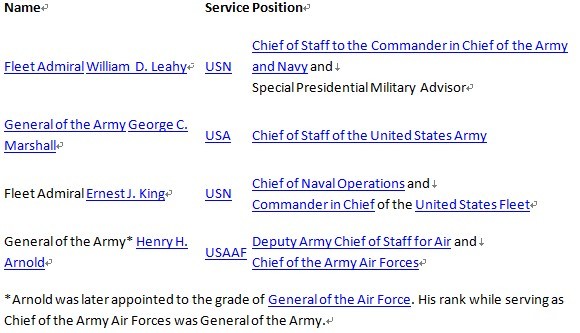
One of the Joint Chiefs of Staff's committees was the Joint Strategic Survey Committee (JSSC). The JSSC was an extraordinary JCS committee that existed from 1942 until 1947. It was "one of the most influential planning agencies in the wartime armed forces." Members included Lieutenant General Stanley D. Embick, U.S. Army, chairman, 1942-, Vice Admiral Russell Willson, U.S. Navy, 1942-1945, Vice Admiral Theodore Stark Wilkinson, U.S. Navy, 1946, and Major General Muir S. Fairchild, U.S. Army Air Force, 1942-.
National Security Act of 1947

US Joint Chiefs of Staff, November 1989
With the end of World War II, the Joint Chiefs of Staff was officially established under the National Security Act of 1947. Per the National Security Act, the JCS consisted of a Chairman, the Chief of Staff of the Army, the Chief of Staff of the Air Force (which was established as a separate service by the same Act), and the Chief of Naval Operations. The Commandant of the Marine Corps was to be consulted on matters concerning the Corps, but was not a regular member; General Lemuel C. Shepherd, Jr., Commandant in 1952–55, was the first to sit as an occasional member. The law was amended during the term of General Louis H. Wilson, Jr. (1975–79), making the Commandant a full-time JCS member in parity with the other three DoD services.
The position of Vice Chairman was created by the Goldwater–Nichols Act of 1986 to complement the CJCS, as well as to delegate some of the Chairman's responsibilities, particularly resource allocation through the Joint Requirements Oversight Council (JROC).
General Colin L. Powell (1989–93) was the first and, as of 2011, the only African American to serve on the Joint Chiefs of Staff. General Peter Pace (Vice Chairman 2001–05; Chairman, 2005–07) was the first Marine to serve in either position. No woman has ever served on the Joint Chiefs of Staff.
National Defense Authorization Act of 2012
A provision in the 2012 National Defense Authorization Act added the Chief of the National Guard Bureau to the Joint Chiefs of Staff. Guard historians called it the "most significant development" for the National Guard since the Militia Act of 1903.
Roles and responsibilities
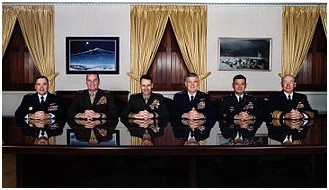
The Joint Chiefs of Staff, November 2002.
After the 1986 reorganization of the military undertaken by the Goldwater-Nichols Act, the Joint Chiefs of Staff does not have operational command of U.S. military forces. Responsibility for conducting military operations goes from the President to the Secretary of Defense directly to the commanders of the Unified Combatant Commands and thus bypasses the Joint Chiefs of Staff completely.
Today, their primary responsibility is to ensure the personnel readiness, policy, planning and training of their respective military services for the combatant commanders to utilize. The Joint Chiefs of Staff also act in a military advisory capacity for the President of the United States and the Secretary of Defense. In addition, the Chairman of the Joint Chiefs of Staff acts as the chief military advisor to the President and the Secretary of Defense. In this strictly advisory role, the Joint Chiefs constitute the second-highest deliberatory body for military policy, after the National Security Council, which includes the President and other officials besides the Chairman of the Joint Chiefs.
Current Members of the Joint Chiefs of Staff
The Members of the Joint Chiefs of Staff:
Notes:
• The Joint Chiefs do not include the Commandant of the Coast Guard, Admiral Robert J. Papp, Jr. The Coast Guard is normally under the Department of Homeland Security, whereas the other four branches are under the Department of Defense. The Coast Guard may operate under the Department of the Navy during wartime.
Leadership
Chairman

The Joint Staff Organization Chart as of January 2012.
The Chairman of the Joint Chiefs of Staff is, by law, the highest ranking military officer of the United States armed forces, and the principal military adviser to the President of the United States. He leads the meetings and coordinates the efforts of the Joint Chiefs of Staff, comprising the Chairman, the Vice Chairman of the Joint Chiefs of Staff, the Chiefs of Staff of the United States Army and United States Air Force, the Chief of Naval Operations, and the Commandant of the United States Marine Corps. The Joint Chiefs of Staff have offices in The Pentagon. The Chairman outranks all respective heads of each service branch, but does not have command authority over them, their service branches or the Unified Combatant Commands. All combatant commanders receive operational orders directly from the Secretary of Defense.
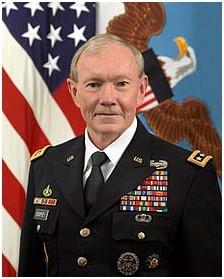
General Martin E. Dempsey, USA, 18th and current Chairman of the Joint Chiefs of Staff.
The current Chairman is General Martin E. Dempsey, USA, who began his term on 1 October 2011.
On 20 July 1942, Navy Fleet Admiral William D. Leahy became the Chief of Staff to the Commander in Chief of the Army and Navy (20 July 1942 – 21 March 1949). He was not technically the Chairman of the Joint Chiefs of Staff. Leahy's office was the precursor to the post of Chairman of the Joint Chiefs of Staff. That post was established and first held by General of the Army Omar Bradley in 1949.
Vice Chairman
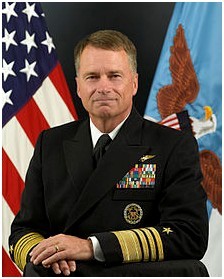
Admiral James A. Winnefeld, Jr., USN, 9th and current Vice Chairman of the Joint Chiefs of Staff
The position of Vice Chairman of the Joint Chiefs of Staff was created by the Goldwater-Nichols Act of 1986. The Vice Chairman is a four-star-general or admiral and, by law, is the second highest ranking member of the U.S. Armed Forces (after the Chairman of the Joint Chiefs of Staff). In the absence of the Chairman, the Vice Chairman presides over the meetings of the Joint Chiefs of Staff. He may also perform such duties as the Chairman may prescribe. It was not until the National Defense Authorization Act in 1992 that the position was made a full voting member of the JCS.
The current Vice Chairman is Admiral James A. Winnefeld, Jr., USN.
Senior Enlisted Advisor to the Chairman
Sergeant Major Bryan B. Battaglia, USMC, 2nd and current Senior Enlisted Advisor to the Chairman of the Joint Chiefs of Staff.
Command Sergeant Major William J. Gainey, USA, was selected to serve as the first Senior Enlisted Advisor to the Chairman of the Joint Chiefs of Staff (SEAC) beginning 1 Oct 2005. It was to be a newly-created position established to advise the Chairman on all matters involving enlisted personnel in a joint environment.
The Senior Enlisted Advisor to the Chairman of the Joint Chiefs of Staff is currently Sergeant Major Bryan B. Battaglia, USMC. Battaglia was sworn in by Joint Chiefs Chairman Gen. Martin Dempsey on 30 September 2011 in a ceremony at Joint Base Myer-Henderson Hall, Virginia.The position had been vacant since CSM Gainey's retirement on 25 April 2008.
As the SEA to the Chairman of the Joint Chiefs of Staff, the SEAC is an advisor to the Chairman on all matters concerning joint and combined total force integration, utilization, and development. Additionally, the SEAC helps develop noncommissioned officers (NCOs)-related joint professional education, enhance utilization of senior NCOs on joint battle staffs, and support the Chairman’s responsibilities as directed.
The Joint Staff
The Joint Staff (JS), composed of personnel from all the four services, assists the Chairman and the Vice Chairman in discharging their responsibilities. They work closely with the Office of the Secretary of Defense (OSD), the Military Department staffs, and the Combatant Command Staffs.
While serving as Chairman or Vice Chairman of the Joint Chiefs of Staff, Chief of Staff of the Army, Chief of Naval Operations, Chief of Staff of the Air Force, Commandant of the Marine Corps, or Commandant of the Coast Guard, the salary is $20,263.50 a month, regardless of cumulative years of service computed under section 205 of title 37, United States Code.3.
Director of the Joint Staff
The Chairman of the Joint Chiefs of Staff is assisted by the Director of the Joint Staff, a three-star officer who assists the Chairman with the management of the Joint Staff, an organization composed of approximately equal numbers of officers contributed by the Army, the Navy and Marine Corps, and the Air Force, who have been assigned to assist the Chairman in providing to the Secretary of Defense unified strategic direction, operation, and integration of the combatant land, naval, and air forces.
Share this page



















